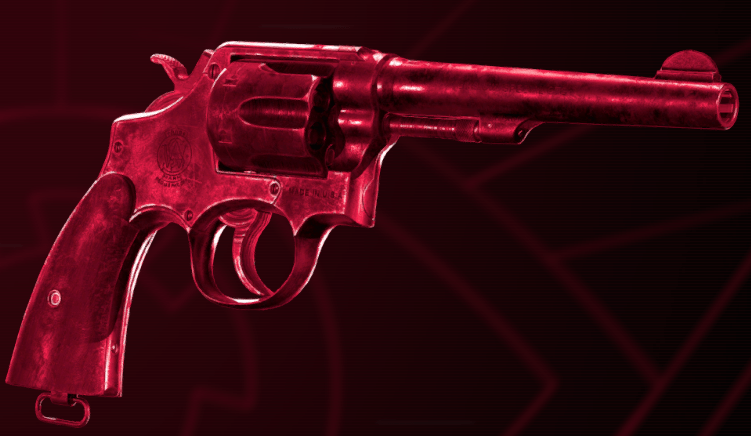Firearms List (Arsenal Guide)
S&W Model 10

Smith & Wesson .38 Hand Ejector Model of 1899, Military & Police, Model 10
Capacity: 6, .38 Special
History:
- The Model 10 set the pattern for all modern revolvers, and will always be the most popular handgun of the 20th century. It was especially popular with American law enforcement, and dominated that market until it was replaced by high-capacity “wonder nines” in the 80s. Early Model 10s were designed to fire .38 Long Colt and only later modified for the more powerful .38 Special. These converted Model 10s fired well, but sometimes failed to extract fired cartridges in the first stroke of the ejector rod.
In-game Brief:
- Before taking long shots, you can manually pull back the hammer to make the trigger more sensitive. S&W cylinders rotate counter-clockwise, so if any chambers are disabled, you can minimize the effects by making sure that one disabled chamber is lined up with the uncocked hammer, and any others are to the left. To safely holster the Model 10, make sure that the hammer is not cocked.
Notes:
- The Model 10’s cylinder spins counter-clockwise as opposed to the Colt Detective Special’s cylinder which spins clockwise. Therefore, loaded rounds should be on the left of an uncocked hammer in order to fire. Revolvers are generally more reliable than their semi-automatic counterparts, not suffering from malfunctions such as stovepipes and FTF (failure to feed). Take caution with a cocked revolver, as it may fire on you if you do not slowly holster the weapon.

A fully loaded Model 10 waiting to be fired.

Hammer cocked back and taking aim, the Receiver prepares to let a round fly downrange.

After missing all their shots, they sheepishly open the cylinder and eject the spent casings with the ejection rod.
Colt Detective Sp.

Colt Detective Special
Capacity: 6, .38 Special
History:
- The Colt Detective Special was introduced in 1927 to give undercover detectives and off-duty police officers enough concealed firepower to effectively engage gangsters wearing body armor. It became an enduring icon of film noir and detective fiction, and its commercial success contributed to the first major wave of concealed carry restrictions in the United States, co-authored by the NRA.
In-game Brief:
- The Detective Special has high mechanical accuracy, but a short sight radius, making it difficult to aim at distant targets. If you must attempt long shots, focus on the breath, and manually pull back the hammer to make the trigger more sensitive. Colt cylinders rotate clockwise, so if any chambers are disabled, you can minimize the effects by making sure that one disabled chamber is lined up with the uncocked hammer, and any others are to the right. To safely holster the Detective Special, make sure that the hammer is not cocked.
Notes:
- Much like its Smith & Wesson counterpart, the Colt Detective Sp. is a .38 Special 6-round double-action revolver. The main difference between the two are the barrel lengths and cylinder rotation. The Colt Detective Sp. has a much shorter barrel length, intended for concealed carry, and as thus suffers from a reduced accuracy. The gun’s cylinder spins clockwise as opposed to the Model 10 (which spins counter-clockwise). Take caution with a cocked revolver as fast-holstering it will cause it to fire apon you.

A Receiver holding his Colt Detective Sp. with a cylinder full of rounds.

Preparing to fire the pocket revolver with the hammer forward. This method of firing is slower than pulling back the hammer due to the double-action mechanism.

Having just taken care of some wrongdoers, they empty their Colt Detective Sp. and prepare to load fresh cartridges in.
Colt M1911

Colt Government – Automatic Pistol, Caliber .45, M1911
Capacity: 7+1, .45 ACP (Automatic Colt Pistol)
History:
- The Colt M1911 is widely considered to be one of the most elegant and best-shooting handgun designs of all time, and remains popular after more than a century of active service. Almost all modern semi-automatic pistols are based on this design, making it the most famous of John Browning’s many firearm designs. The 1911 became the official US Army sidearm, replacing .38 revolvers like the Model 10, and held that position until it was replaced in 1985 by the Beretta M9.
In-game Brief:
- The 1911 is a single-action weapon, so before firing you must engage the hammer by either pulling it back directly or by racking the slide. If the hammer is back and you can see brass in the chamber with a press check, then it should fire at least once, even under the disruptive influence of the Threat. Novice shooters often experience “stovepipe” malfunctions with follow-up shots, where the spent cartridge gets caught in the ejection port. You can clear this malfunction by tilting the weapon and manually racking the slide to clear the spent cartridge and chamber a new one.
Notes:
- The Colt M1911 is one of the first few semi-automatic weapons you will find in Receiver 2. It features a thumb safety and cannot be fired if the hammer is forward, making this handgun one of the safer weapons to operate. The sight picture won’t be easy to get used to at first due to a thick rear sight but can be mastered with practice.

A full M1911 magazine ready to be loaded into the weapon.

The Receiver inserts the magazine and pulls back the slide to chamber a round.

Now loaded, they perform a press check to confirm that the round is loaded in the chamber.

Taking aim…

…and firing a bullet. Not pictured is the accompanying blink that the Receiver reflexively performs every time a weapon is discharged.

Relieving the pistol of its empty magazine, the Receiver inspects both items.
Glock 17

Glock 17 with select-fire mod
Capacity: 17+1, 9x19mm NATO
History:
- When Gaston Glock presented the Glock 17 pistol to the Austrian army as a companion sidearm for the Steyr AUG, it marked the beginning of the end for classic steel-framed hammer pistols. There are pros and cons to Glock’s polymer-frame and striker fired design, but its light-weight, reliability, low production cost, and shrewd marketing allowed Glock to quickly achieve a dominant position in the handgun market. Glock pistols can easily be converted to allow fully-automatic fire.
In-game Brief:
- The Glock 17 has no external safety switch or decocking device, so you can only safely holster it by making sure that you maintain focus throughout the whole process (by holding down the holster key), or by making sure that the chamber is empty. To do that, you can eject the magazine (default key: E), then get ready to catch the ejected round (default key: G), rack the slide (default key: R), and re-insert the magazine (default key: Z).
Notes:
- The Glock 17 boasts the highest capacity of any other weapon at 17+1. It is the only handgun (and the only weapon) in the entire game to fire in full automatic (when switched to auto). Doing so however should only be saved for emergencies and will usually jam the weapon very quickly. The Glock 17 has no safety switch, nor a hammer, making this a dangerous weapon to use if one is not careful. The only ways to safely holster this weapon is to slow-holster or eject the magazine and clear the chamber.

‘A Receiver with a Glock 17 and their complimentary Glock 17 magazine. The holes on the magazine indicate the amount of rounds loaded.

Inserting the magazine and racking the slide.

A press check confirms a round has been chambered. Ready to fire!

The sight picture of the Glock 17. Offers enough clearance to see your target.

Firing the weapon. No casing is visible because the slide is still riding back.

There it is!

An empty gun is a sad gun. The Receiver takes out the empty magazine and prepares to load in a new, full magazine.

The Glock 17 on fully automatic. The select-fire switch has been pulled out to the right, indicating auto.

As expected, trying to aim the weapon on fully automatic is nigh impossible.
Desert Eagle

Desert Eagle Mark I
Capacity: 7+1, .50 AE (Action Express)
Specifications:
- The Desert Eagle has a unique gas-operated rotating bolt mechanism, more like an AR-15 than like any other pistol. Its massive fixed barrel and lacking bolt allows it to withstand very high pressures, blasting 300-grain .50 caliber rounds downrange at Mach 1.3. The Desert Eagle has no valid military or law enforcement use. It is occasionally used for handgun hunting and long-range target shooting, but is mostly used to annoy everyone at the shooting range.
In-game Brief:
- The Desert Eagle’s intense recoil can make follow-up shots difficult, but if the first shot hits, it’s usually enough. It generally won’t jam if you keep a firm grip and keep your hands off the magazine (no teacupping).
Notes:
- The Desert Eagle is the hardest-hitting weapon in the game, chambered in a wrist-spraining .50 Action Express. Your player will most certainly have trouble managing the recoil, and as the brief states, follow-up shots will take much longer than with other weapons. However, due to the caliber of the weapon, a bullet can knock down a ground turret if it hits an area far from the center-of-gravity. Use this to your advantage as other handguns do not pack this amount of force. The Desert Eagle Mark I cannot fire if the hammer is not engaged, similar to the M1911.

Pleased with his purchase of a fully-working Desert Eagle Mark I, the giddy Receiver shows off his new loot.

Fitting the oversized magazine into the oversized handcannon and chambering a round.

Suddenly teleporting to the shooting aisle left of them, the Receiver ignores this change in location and performs a press check. The cartridge is ready to be fired.

Aiming the Mark I…

…and firing the gun. The Desert Eagle’s famous “Ring of Fire” is pictured.

A casing prepares to take flight, leaving its un-shot brothers behind in the nest. Fly, O’ spent one!

The Receiver holds up his empty magazine and gun like the corpse of a prized buck.
